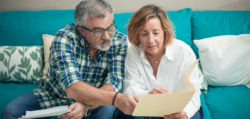
Downsizing is the term used when older Australians sell a family home and relocate to a smaller, low maintenance residence. This often involves the move from a house to an apartment or unit, or to a residential village. It’s also a term used in ‘Downsizing contributions’ when, under certain conditions, funds made from the sale of a more expensive property can be moved into super without many of the normal restrictions applying.
It’s easy to believe that downsizing is the ‘new black’ – a trend that’s taking over for retirees. But that’s not quite the case. In fact recent research tells a very different story. According to Professors Phelps, Ong Viforj and Clark, a hefty 86% of older Australians already live exactly where they wish to stay. Specifically, 67% strongly prefer to stay in their current neighbourhood and 19% have a moderate preference to do so. This is not quite the rush to ‘up stakes’ and move that the media portrays.
That’s probably because moving home is one of the highest ranking items on the list of stressful life occurrences. It’s also no doubt due to the complex mix of emotional, financial and logistical challenges associated with selling up and buying something smaller.
The following is a brief list of the major pros and cons which older Australians confront when they are considering downsizing. It’s entirely personal how important each factor might be in your life, but they are all worth thinking about.
Good reasons to move:
More funds – Downsizing can release home equity and allow you to reduce or pay off your mortgage, put more money into super or spend on long awaited travel or other lifestyle wishes.
Reduced maintenance needs – A smaller home can be much easier and cheaper to maintain.
Age appropriate accommodation – This may involve moving closer to amenities or family or buying a residence will remain accessible as you age.
Reduced outgoings – this might include lower energy, water and insurance costs
Why you may wish to stay where you are:
Emotional reasons – Many older Australians have raised families in their homes. Others may simply have created years of good memories. This can make it hard to sell. It’s not a measurable reason, but one that proves the strongest when deciding.
Less space – Maybe you simply enjoy the luxury of a study or dining room or larger garden. Units and apartments don’t suit everyone. Nor is everyone suited to dealing with residents’ committees or body corporates. You may also enjoy having guests to stay, entertaining or extra room for four-legged friends.
Changing neighbourhoods – If you are deeply attached to your local doctor, pharmacist, hairdresser and fruit and veg shop, then the idea of a new neighbourhood can seem like hard work.
Costs – as we outline below, the cost of downsizing can take a large chunk out of your expected profits. It’s important to understand all the ‘hidden’ costs before you decide to sell.
Downsizing contributions
We’ve previously covered the way you can use profits from the sale of your primary residence to top up your super. There are quite a few conditions attached to this strategy and it’s important to scope the potential costs as well as the effect that extra funds may have on other retirement income streams, particularly the Age Pension. Remember, you will be moving money from an exempt asset (your home) to a potentially non-exempt asset, where income will be deemed. There are limits on how long funds can be held before Centrelink deems this money as income-earning, so it’s important to acquaint yourself with these rules.
Make sure you get the sums right
Separately, it’s often the case that we get excited when a neighbour or friend sells for what sounds like an impressive amount, and they repurchase a property for much less. Most of us will do the ‘simple sum’ of sale price of old house less purchase price of new house and think that’s the profit we too might make.
Wrong! There is a long list of costs involved in downsizing and these could possibly reduce your expected profit by as much as 12-15%. The table below shares some indicative costs for the purchase of a two-bedroom home in in the Victorian town of Ballarat.
| Purchase price of smaller home | $950,000 |
| Stamp duty (on property) now called land transfer duty in vic | $52070 |
| https://www.e-business.sro.vic.gov.au/calculators/land-transfer-duty | |
| Conveyancing expenses | $2000 |
| Rates | $1850 |
| Utilities connection | $120 |
| Internet/phone connection | $250 |
| Other (security, dog proofing etc) | $1100 |
| House insurance | $2500 |
| Contents insurance | $900 |
| ‘make good’ repairs | $1500 |
| Removalist | $2500 |
| Moving insurance | $950 |
| Total | $65740 or additional 7% of purchase price |
It’s sobering how a home that costs under $1 million can suddenly cost $65,740 more when the actual costs of this sale are projected.
The costs of selling the existing property (real estate agent, auction costs etc) have not been included, but would need to be to gain a better understanding of the net profit from your previous home.
There are no right or wrong answers when retirees think about downsizing, just answers that are most appropriate to your age, stage, health, hobbies and activities and support needs. The main thing is to think through all the upsides and downsides first. And to make sure, if you are a couple, that both of you are happy with the decision.
Seeking advice on the implications of a property sale on your retirement income makes a lot of sense. Why not book an Understanding the impacts of your home consultation to check how well this might work for you? You can also see how the proceeds from selling your home can impact your entitlements in a Maximising your entitlements consultation.
You can also check the likely government fees on a property sale in your own postcode by using this handy calculator.
How do you feel about downsizing?
Are you excited at the idea of a smaller, newer abode?
Or are you a ‘carry me out in a box’ type?






Well done. Very succinctly written. I have recently downsized and although I thought I had organised “the moving” well it was nevertheless very stressful. An elevated blood pressure was the tell tale sign.
Hi Frederick, thanks for your quick and positive response to this article. The emotional costs of downsizing are often overlooked or unacknowledged so having some ‘real life’ feedback is enormously helpful for others who may be considering a move, warmest, Kaye
I was on the cusp of selling and downsizing from my 3 acre property with a small, but comfortable, house. This property is not worth a lot of money, so to sell and buy something smaller, more manageable and closer to amenities would only free up about $100K.
Plus, after the freedom of having a space so large and beautiful to myself, it would be a step down in my opinion.
I’ve decided that it’s not worth the sacrifice of lifestyle.
I’m 71 and feel I can comfortably manage this beautiful property until I’m at least 75. At that stage I may feel more comfortable living in more cramped conditions with less work. Thanks for your article, you have confirmed what I was thinking.
Hi Sue, thanks to you for sharing your situation and your thinking with regard to downsizing. As we suggested, the decision to downsize is so personal, with so many factors attached, that money is just one part of the decision-making priority list. We hope you have many more happy years in what sounds like paradise! warmest, Kaye
I am a retired accountant, and I consider the emotional ‘stuff’ last. Downsizing is and has been promoted by successive governments as a way of releasing family homes to those who need them and a part solution to the ‘housing crisis’. A cop out (in my opinion). The fact is, when you downsize, you are up for stamp duty on your new purchase. Easy money for state governments. If governments are serious about downsizing, then there should be some exemption or at least some relaxation of the stamp duty payable when downsizing.
Absolutely spot on. Stamp duty is more for jam – money for inept inefficient goverment to blow on whatever. So called “downsizing” can easily cost over $100K, a very large portion of qhich goes into Government coffers. You can buy a lot of help with $100k
I downsized and received the one off discount on stamp duty you must have a concession card or health card
Hi Rose – I am almost 70 years old & in the same process now, would love to know how to obtain this discount as it is critical as I am on age pension but wife not old enough and can’t get a job at 58 years old.
We are looking like paying around $57000 Stamp Duty to downsize.
I have an age pension card & seniors card. Wife of course has neither.
Hope you can help with this
Thanx in advance
Jim
Downsizing when you are substantially older is no easy feat. If buying land and building a house, it will cost more to downsize. While stamp duty only applies to the land, my new build to accommodate my aged related lifestyle, is at $2300 a square metre. Up from $1800 only four years ago.
Hi just a comment about the pitfalls of downsizing to a retirement unit in Sydney. 28 years ago my parents decided to move to the other side of Sydney which had a Dutch community even though they lived Australia most of their life. My mother died 5 years ago and, at 93, he is feeling lonely and unhappy. The village is no longer a Dutch village as second generations don’t want to live there.
My sister and I have been looking into moving him closer as it’s a four hour round trip by public transport and we are approaching 70s ourselves with health issues.
We were shocked to find that after the Deferred Management Fee of 30% (taken over first 6 years of occupation coupled with no capital gain over the nearly 30 years he has been there a pitiful amount would be available to finance the move to local aged care facility that requires a $900,000 bond.
So retirees must research the financial implications and be very sure which village they want to move to as there will be no option to move a second time.
I too found this fascinating, thank you. I’m a “carry me out feet first in a box” type, but one never knows – a massive stroke or other catastrophe could force a move. So it was with my mother, who hated retirement living but would not move countries to live with her children and leave her life and friends (totally fair enough). But I’m interested to hear that some 86% feel as I do.
Hi Barney, thanks for your feedback. I’m a carry me out in a box person too, but I wonder if that is unfair on our adult daughters as they will have a lot to wrangle with a big, old family home … warmest, Kaye
It is good to hear of the many factors for people facing or completing downsizing.
The costs listed were conservative in our experience. There is quite a pressure now from agents to have a complete repaint and styling.
This can mean moving out while work is done and or while the sales campaign is on as its not much fun coping with several types of trades all working at once.
Disposal costs are also quite significant downsizing is not just rooms but contents.
We filled several trucks worth of stuff to go to the tip despite months of effort to sell or donate stuff we wouldnt be taking with us. In the end we ran out of time had to send goods to the tip.
We sold a 5 bed house tailored to our needs and have bought a 3 bed unit interstate which will need some adjustments and different furniture. Others tell us that you tend to refurnish anyway so probably we should have culled even more of what was kept aside for the new place.
So there are removal costs but also some temporary accommodation and storage as well We forgot to buy that investment property decades ago that might have funded buying a house to move to before sale of our old house. We did well with the sale despite costs inc land tax, of 120K. We had the funds to cover costs upfront and could spare ourselves a lot of stress but it is stressful.
We are 74 and wish we had moved a bit earlier to relocate and reestablish networks in a new city but are so glad we did it now and not at 84!
I advise friends to start culling 10% of goods per year so they are better prepared. Maybe get an agent to assess what might need to be done for a sale and get repairs done.
Hi Gael, many thanks for this detailed and thoughtful response. there is nothing better than real life experience, so sharing how downsizing worked for you is enormously helpful to our other members. And the advice to start culling early is very sound, warmest, Kaye
A wonderful and in depth article Kaye, and I’m so interested to read all the feedback.
I love Gael’s tip of reducing your house contents by 10% each year, as I’m sure this would be worthwhile for so many of us.
As part of my interior design and decoration business and helping our clients in the process of downsizing is one of our services. First, I have a discussion around what are the items you truely love, meaning, what would you try to rescue in the event of a fire? Then, I get my clients to consider their ‘collections’…we no longer have use for 36 cheese platters, for instance. Just keep the things you love to use all the time and then, as you suggest Gael, think about gifting to family or even friends, and start doing it now.
From a design/decoration point of view, I think it’s important for 1. to bring into your new home (only) the things dear to your heart, 2. to purchase updated, new things to breath new energy into your existing pieces, and so you can feel you’ve ‘moved forward’. You don’t want your new home to be a time capsule of what’s been translocated from your old home.
Some people make the mistake of clearing out/selling everything from their large family home, but really most people need some references to ‘home’ in their new residence, especially when moving neighbourhoods.
Moving house is stressful and exhausting at any age – but we forget, especially as we grow older. We’ve had clients who have tackled the whole culling/editing process themselves and have literally run out of puff. They then don’t have the energy to decorate their new home. I think you want your new home to be the home you’ve always wanted. Not only does it need to look wonderful but it needs to tick the boxes for comfort, safety, convenience, and sustainability.
I must admit, all the costs Kaye has outlined, and those contributed, are pretty scary but you need to be realistic about what you’re physically and emotionally capable of. Having help does cost a little more but it can also help to save you money. Understanding what your new home can or cannot accommodate will easily help, and being armed with that advice before moving will definitely do so.
thanks for sharing these thoughts Kym – I am sure our other members will find these insights really helpful. Particularly the reference to emotional capacity. I’m aware that, in writing about financial costs, it can seem that the other dynamics are less important. They’re not – and discussing these things with nearest and dearest can help a lot, warmest Kaye
Thanks for covering these important topics!
We downsized to a unit after my husband had a stroke 8 years ago. The unit was new and the strata fees were $1,000 per quarter. That was manageable. After 8 years however, the strata fees are now 8,000 per annum. We are left wondering if we can afford to stay when we both stop working. It’s an issue that people may encounter and need to be made aware of.
Wow Marcia – that is an awfully high hike in strata fees – so we appreciate you highlighting it. Is there any way of pushing back via an owners association? We hope your husband is doing ok. And that you can stay on top of these expenses, warmest
Kaye
Terrific article Kaye,
Would think the cost of selling here in VIC to be very similar to the costs of buying that you listed?
Hi Sean, thank you – that’s very kind! I did research with real estate agent, utlities provider and an accountant to check these costs so I would need to do the same thing before commenting on purchase costs, with or without a loan etc. It could make another helpful article though, as it’s the other side of downsizing, isn’t it? warmest, Kaye
Just a followup on my previous comments. If you own your own home/unit and are Australian and wish to stay after retirement but worried you cannot afford it Centrelink offers the Home Equity Scheme. They will pay up 150% of the current pension either fortnightly or in two lump sums per year which you can repay anytime or not till your estate is finalised. Interest rate is much less than private equity companies.
In the meantime your property likely will have a handsome capital gain and the repayment would be more than covered. You can always arrange assistance to help with home care.
Much better financial decision than a retirement unit in a village. That will be my choice when I give up work.
Good article but you failed to mention the land tax reduction offered in Victoria to aged pensioners when selling their family home and “downsizing “. It is a one time offer and on a sliding scale depending on price paid for new purchase. If you can wait until you receive a pension/part pension it may be helpful to some.
Hi Lynn, Many thnaks for noting that reduction – here’s the full detail for those interested, from the Vic gov website – in our example, the property was above the $750,000 limit, so that was why this was not included. warmest, Kaye. This is from the Vic SRO website:
https://www.sro.vic.gov.au/buying-property#pensioner
Buying a home as a pensioner
A one-off pensioner and concession cardholder duty exemption or concession is offered to all eligible pensioner and concession cardholders, including those who are first home buyers, for homes valued up to $750,000.
You may qualify for the first home buyer duty exemption, concession or reduction and a one-off pensioner and concession cardholder duty reduction when buying your home.
You cannot, however, receive both so you must elect to receive one or the other when you submit your application form.
If you signed your contract before 1 July 2023, you can calculate your duty to work out which is worth more for you.
We plan to sell and travel Australia in a caravan for 12 months. I’m told the money from the sale is not means tested as an asset for twelve months therefore not impacting any pension we receive, however, is the bank interest earned while traveling for the 12 months included as income by Centrelink? If so the one million dollars from the sale invested at 4-5% interest would be at least $40K per year, therefore we would lose our pension. We intend to purchase another home after the 12 months.
Hi Vinnie, thank you for reaching out. Centrelink will actually place an exemption from asset testing for 24 months (not 12) on the funds you intend to use to buy your new home but yes the full balance still has income deemed from it, the is no exemption on the deeming.
How are rates, home insurance and contents insurance “additional” costs of downsizing? Those expenses are there whether you move or otherwise and in fact those costs are likely to reduce with downsizing.
Hi Richard, you make a good point as these costs could be a similar amount to previous. They can, however, incur upfront payments that are not taken into consideration before any refunds from other properties are received. There are also many instances when the term ‘downsizing’ actually involves ‘rightsizing’ which in some cases can involve purchasing a larger property (which does not necessarily cost more), but does involve higher rates or insurances. The most important thing is to understand all possible costs at the time, even if some will be ameliorated by refunds. warmest Kaye